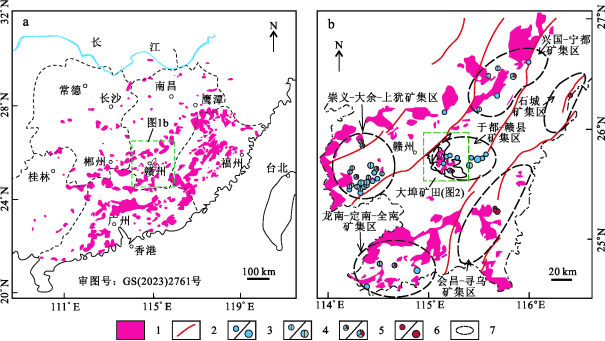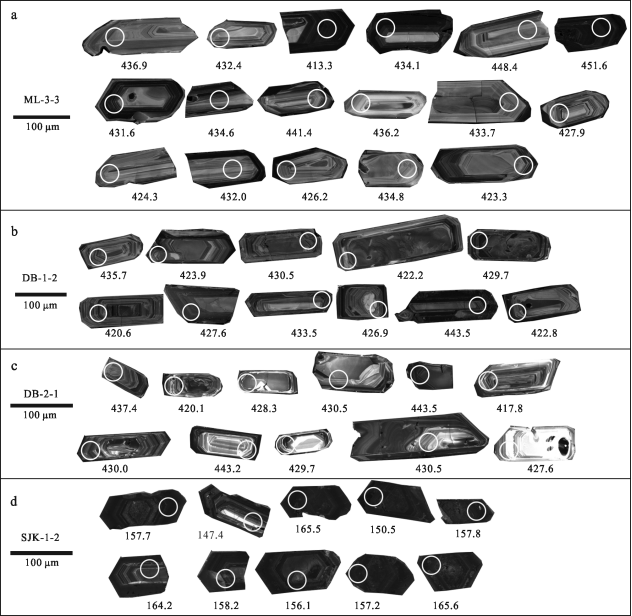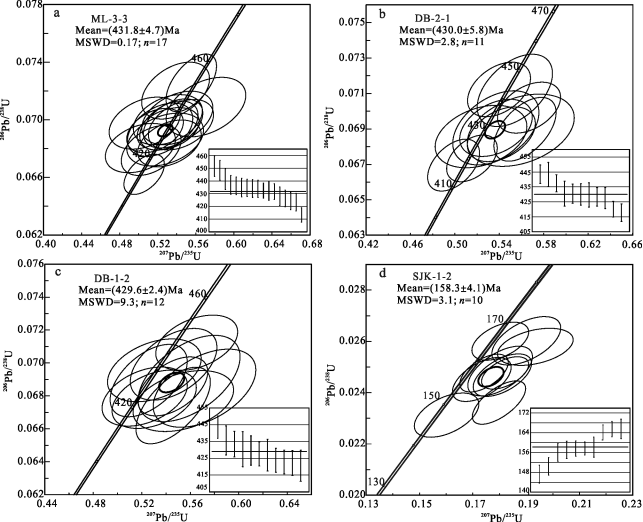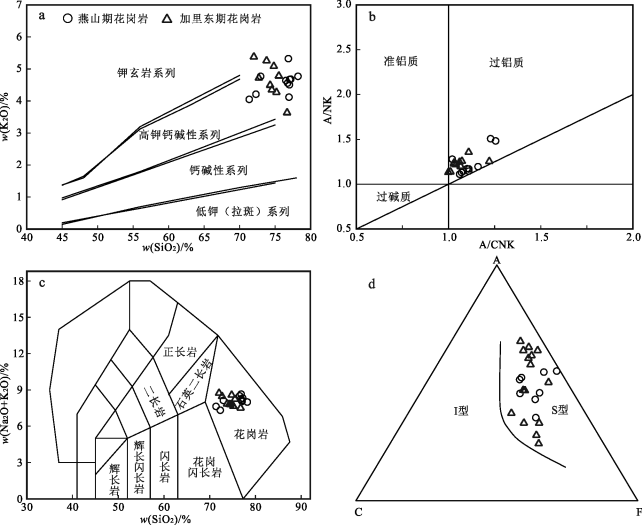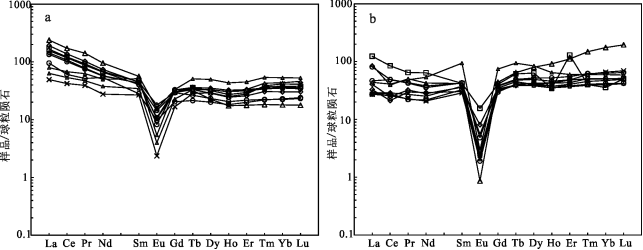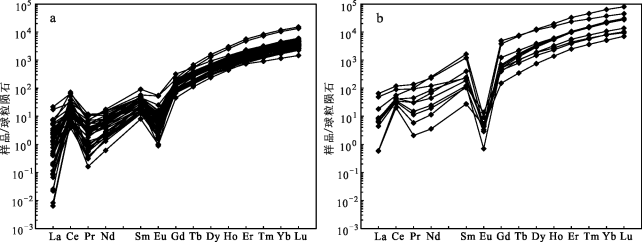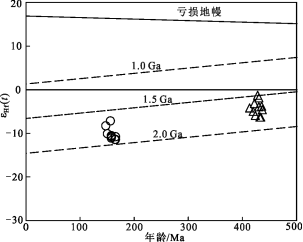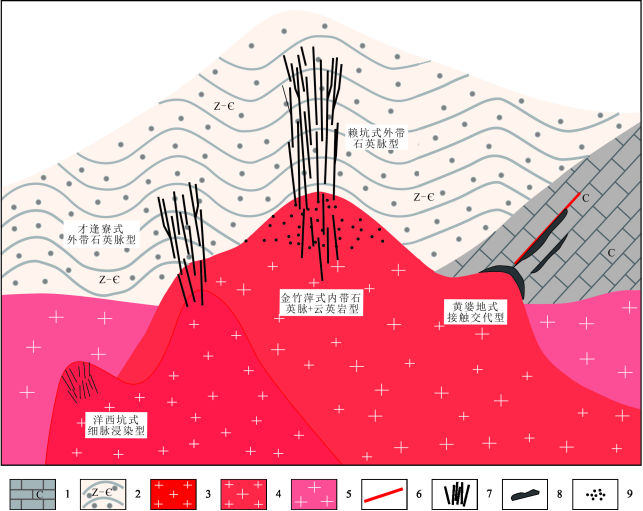-
南岭地区是中国钨、锡、钼、铋、铀、稀土元素等多种战略性矿产资源基地,大量研究表明区内的钨、锡等多金属矿化与花岗质复式岩体密切相关,如骑田岭、千里山、大吉山岩体等(Zhao et al., 2000;蒋国豪等,2004;朱金初,2009)。大埠矿田位于南岭东段于都-赣县钨多金属矿集区中心位置、盘古山矿田的西北部、银坑矿田的西南部,矿田内出露的大埠岩体同样也是复式岩体,出露面积超400 km²。矿田内已发现的产于岩体内部及外围五十余处钨多金属矿床(点),近年来深部找矿取得了重要突破,发现了产出于深部隐伏岩体内的“合龙式”钨矿(尹政等,2021)。前人对大埠矿田区域地质、矿床地质、岩浆岩特征开展了研究(梁景时等,2012;赵磊等,2013;邵飞等,2014a;王丽丽,2015;孟雷等,2016;邬斌等,2020;李海立等,2020;Zhang et al., 2021;尹政等,2021)。然而,大埠地区岩浆作用具有多期次、多阶段的特点,关于各类花岗岩的成岩时代争议颇多,一部分学者认为成岩时代是加里东期(王丽丽,2015;刘静等,2015),一部分学者认为是燕山期(朱书奇,2016),另有部分认为是加里东期和燕山期两期次(方贵聪等,2017),缺乏系统的成岩成矿时代及各类花岗岩与成矿关系研究,一定程度上制约了区域成矿规律研究和勘探工作部署。本文在矿田地质调查的基础上,对大埠不同期次花岗岩开展了LA-ICP-MS锆石U-Pb年代学、锆石微量元素和Hf同位素分析,建立大埠矿田的成岩成矿时代格架,探讨不同期次岩浆活动对成矿作用的贡献,建立勘查模型并进行找矿预测,对推动赣南地区钨多金属矿找矿勘查具有重要的实际意义。
1区域地质赣南地区位于南岭稀有金属成矿带东段,区内出露的地层较为完整,震旦系—寒武系发育岩性主要为浅变质砂岩和板岩,为本区的基底地层,中泥盆统—二叠系发育岩性以碳酸盐岩和含炭碎屑岩为主,三叠系地层缺失,侏罗系—白垩系为一套内陆河湖相膏盐建造,分布最广的震旦系—寒武系基底及泥盆纪钨含量高于地壳克拉克值的几倍至几十倍。研究区处于南岭东西向构造带和武夷-云开褶皱带的交汇复合部位(图1a),经历了多次构造运动和长期、复杂的发展演变过程,致使区内断裂、褶皱构造十分发育,断裂形成“三纵三横”并叠加少量北东向、北西向、南北向的构造格架(刘善宝等,2007;Zhao et al.,2018),各个方向上的断裂将区域内的地层和岩体分割成棋盘格状,为成岩成矿作用提供了充分的上侵通道和储矿空间。岩体出露多达400余个,包括加里东、印支、海西、燕山、喜马拉雅5个旋回,燕山旋回为最活跃的时期。印支晚期古特提斯洋闭合引起的陆-陆碰撞及碰撞后伸展作用和燕山期古太平洋板块的幕式俯冲作用,是华南陆块中生代强烈构造岩浆活动与成矿的动力引擎(赵正等,2022;赵文等,2022),板片汇聚后加厚岩石圈的拆沉作用使南岭地区岩石圈减薄,引发软流圈上涌(Zhang et al., 2023),玄武质岩浆底侵(吴福元等,2003;卢汉堤等,2016)进而大规模的区内的富钨、锡的基底地层组成的地壳熔融,导致在中生代南岭地区大范围陆壳重熔型高分异花岗岩的生成(华仁民等,2005)和钨、锡成矿作用的大爆发(华仁民等,1999),燕山早期岩体内富含钨、锡、铌、钽、铅、锌、铜等成矿元素,是区内钨多金属矿的成矿母岩。可将赣南地区自西向东划分为3个成矿带,崇-犹-余、于都-赣县、三南(龙南-全南-定南)、兴国-宁都是区内4个重要的钨多金属矿集区(图1b)。据不完全统计,赣南已知的钨矿床(点)有441处(何维基,2018),其中,中-大型十多处,累计探明钨储量170万t(曾载淋等,2007),有以西华山、盘古山、大吉山、岿美山为代表的“八大”钨矿山。发育的钨矿床类型有石英脉型、云英岩型、花岗岩型、矽卡岩型、破碎带型等,其中以热液石英脉型和花岗岩型为主,储量最大,分布最广。
2矿田地质大埠矿田位于赣南于山钨稀有多金属成矿带的于都-赣县钨钼铋矿集区(图1b)。矿田内出露有震旦系、寒武系、泥盆系、石炭系、二叠系、侏罗系、白垩系和第四系(图2),其中以震旦系和寒武系为主,主要为一套以变质砂岩、板岩为主的类复理石建造;泥盆系—二叠系角度不整合覆盖在基底地层之上,以磨拉石建造开始,以浅海相为主的碎屑岩、碳酸盐岩建造,夹内陆湖泊沼泽相含煤建造;侏罗系—白垩系沉积在断陷盆地之中,为一套内陆河湖碎屑岩沉积建造;第四系堆积物发育在河流、沟谷两侧以及地势低洼地带。
图1华南地区燕山早期花岗岩分布简图(a)和赣南地区主要钨矿床分布简图(b)(底图据Zhao et al., 2018修改)
1—燕山早期花岗岩;2—主断裂;3—中/大型钨矿床;4—中/大型钨钼矿床;5—中/大型钨多金属矿床;6—中/大型锡矿床;7—矿集区
Fig. 1 Simplified maps showing the distribution of Early Yanshanian granites in South China (a) and showing the distribution of main W deposits in southern Jiangxi Province (b) (basemap modified after Zhao et al., 2018)
1—Early Yanshanian granite; 2—Main fault; 3—Medium or large tungsten deposit; 4—Medium or large tungsten and molybdenum deposit;
5—Medium or large tungsten polymetallic deposit; 6—Medium or large tin deposit; 7—Ore cluster
图2大埠矿田地质简图(据1∶200 000于都幅和赣县幅地质图修改)
1—第四系沉积物;2—白垩系砂砾岩;3—侏罗系砂岩、泥岩;4—二叠系砂岩;5—石炭系灰岩;6—泥盆系灰岩、砂岩;7—寒武系变质砂岩;8—前寒武系变质砂岩、板岩;9—燕山晚期侵入岩脉;10—燕山早期花岗岩;11—加里东期花岗岩;12—断裂;13—钨矿床及名称;14—采样点
Fig. 2 Schematic geological map of Dabu ore field (modified after 1∶200 000 geological map of Yudu and Ganxian sheet)
1—Quaternary sediments; 2—Cretaceous conglomerate and sandstone; 3—Jurassic sandstone and mudstone; 4—Permian sandstone; 5—Carboniferous limestone; 6—Devonian limestone and sandstone; 7—Cambrian metasandstone; 8—Precambrian metasandstone and slate; 9—Late Yanshanian intrusive dike; 10—Early Yanshanian granite; 11—Caledonian granite; 12—Fracture; 13—Tungsten deposit and name; 14—Sampling point
矿田地处区域上东西向与北东向构造带交汇处,构造变形强烈,褶皱、断裂构造广布,矿田内北北东—北东向、东西向断裂构造最为发育,叠加少量近南北向、北西向构造,在部分区域构造断裂带呈现网格状分布,将地层切割,矿田内发育的大量深大构造断裂为富钨花岗质岩浆的侵入以及成矿热液的运移提供了通道。
大埠矿田范围内的复式侵入岩体出露面积超400 km²(图2),呈北北东向展布,亦有东西向拉伸之势,按照侵入时代不同,分为加里东期和燕山期2个期次。其中,加里东期岩体以岩基形态产出,构成大埠岩体的主体部分,主要岩性为中粗粒(斑状)黑云母二长花岗岩(图3a~d),也出露有岩性为细粒二云母花岗岩的岩体(图3g、h),以小的岩滴、岩瘤形态产出。燕山期岩体是中生代剧烈的构造-岩浆活动的产物,主要岩性为中细粒黑云母二长花岗岩(图3e、f),根据侵入接触关系、岩相变化等又可将燕山早期岩体分为不同阶段,本文将其划分为2个阶段,第一阶段侵入体岩性主要为中细粒黑云母二长花岗岩,呈似斑状结构,斑晶主要由钾长石、斜长石、石英组成,侵入到早期的加里东期岩体之中(图2),也有相当部分并未出露地表,为隐伏岩体,主要分布在大埠岩体东北部;第二阶段的补体出露较少、主要岩滴、岩瘤形态产出,岩性主要为细粒黑云母/二云母二长花岗岩。除此之外,燕山晚期岩浆活动表现为花岗斑岩、辉绿岩、煌斑岩等岩脉侵入。
矿田范围内已知的钨矿床(点)有安前滩、葛藤凹、长坑、罗井坵、洋西坑、小东坑、才逢寮、草坪嶂、黄婆地、木梓岭、赖坑、金竹萍、东坑等,通过收集前人资料对矿田范围内部分矿床的地质特征、成矿年龄、成因类型等特征进行总结(表1),主要类型为石英脉型,少量的矽卡岩型和花岗岩型(云英岩型、细脉浸染型、蚀变花岗岩型)。矿田内钨矿化在空间上明显受大埠燕山早期两阶段黑云母花岗岩和构造的联合控制,分布在燕山早期侵入岩体的内部及与围岩的内外接触带(图2)。矿田内最主要的外带石英脉型钨矿的赋矿围岩为震旦系—寒武系浅变质砂岩、板岩地层,控矿构造主要是北东—北北东向和东西向断裂,主要矿石矿物为黑钨矿,伴生辉钼矿、辉铋矿、锡石、硫化物等;矽卡岩型赋矿围岩主要为泥盆系—石炭系的富含钙质成分的碳酸盐岩地层,多顺层或在层间破碎带产出,主要矿石矿物为白钨矿,伴生辉钼矿、辉铋矿、硫化物等;此外,岩体内还有少量的花岗岩型钨矿产出。
3样品采集与分析方法3.1样品采集与描述本文采集复式岩体中的4个典型花岗岩样品,分别为中粗粒斑状黑云母二长花岗岩ML-3-3(115°16′10″E,25°36′04″N)、中粗粒斑状黑云母二长花岗岩DB-1-2(115°03′47″E,25°40′50″N)、中细粒少斑黑云母二长花岗岩SJK-1-1(115°06′48″E,25°48′07″N)、细粒二云母二长花岗岩DB-2-1(115°02′50″E,25°40′08″N),挑取4块样品中代表性的锆石进行锆石U-Pb定年和微量元素特征分析,采样位置见图2。
中粗粒黑云母二长花岗岩(ML-3-3):样品呈灰白色-浅肉红色,中粗粒花岗结构,块状构造(图3a、b),主要矿物有钾长石(30%~35%)、斜长石(30%~35%)、石英(20%~25%)、黑云母(10%~13%)和少量的磁铁矿、磷灰石、锆石等副矿物组成。斜长石呈白色,自形-半自形,粒径约3~8 mm;钾长石呈肉红色,半自行-他形,粒径约为2~8 mm,斜长石和钾长石发生绢云母化;石英为无色,呈他形粒状充填在斜长石钾长石颗粒之间,粒径为3~8 mm;黑云母为黑色-暗绿色,自形-半自形,粒径为3~7 mm,出现较强绿泥石化。
中粗粒斑状黑云母二长花岗岩(DB-1-2):样品呈灰白色-浅肉红色,中粗粒、似斑状结构,斑晶为钾长石和石英(10%~15%),钾长石斑状呈自形板柱状,粒度达4 cm(图3c、d),石英斑晶呈他形粒状,粒度为8~15 mm。基质矿物为斜长石(25%~30%)、钾长石(20%~25%)、石英(20%~25%)、黑云母(10%~13%)以及少量石榴子石、锆石、磷灰石等副矿物。斜长石呈灰白色,自形-半自形,粒径在2~8 mm之间,聚片双晶发育;钾长石为肉红色,自形-半自形板柱状,粒径为3~8 mm,斜长石和钾长石晶体内部发生绢云母化;石英为无色,呈他形粒状充填在钾长石、斜长石颗粒之间;另有少量黑云母呈自形-半自形片状,浸染状散布在岩石颗粒之间,沿着晶体边缘发育轻微的绿泥石化。
中细粒黑云母二长花岗岩(SJK-1-2):岩石样品呈浅肉红色,中细粒花岗结构,块状构造(图3e、f);主要矿物为钾长石(35%~40%),斜长石(25%~30%),石英(20%~25%),黑云母(5%~8%)以及少量的锆石、石榴子石、榍石、磁铁矿等副矿物。斜长石呈白色,自形-半自形,粒径约1~4 mm;钾长石呈肉红色,半自形,粒径约为1~5 mm;石英为无色,呈他形粒状充填在斜长石钾长石颗粒之间,粒径为0.5~3 mm;黑云母为黑色-暗绿色,自形-半自形,粒径为0.5~2 mm。
表1大埠矿田内典型钨多金属矿床特征
Table 1 Characteristics of typical tungsten polymetallic deposits in Dabu ore field
矿床名称
矿物组合
矿床类型
成矿岩浆岩
赋矿层位
控矿构造
年龄/Ma
测试方法
规模
资料来源
安前滩
黑钨矿、白钨矿、辉钼矿、辉铋矿、黄铁矿、黄铜矿
外带石英脉型、矽卡岩型
隐伏中细粒黑云母花岗岩
寒武系下统牛角河组和泥盆系中统云山组、上统中棚组
北西向、北东向断裂带
155
辉钼矿Re-Os
小
邬斌等,2020
葛藤凹
黑钨矿、辉钼矿、锡石、辉铋矿、黄铁矿
内带石英脉型
细粒黑云母花岗岩
岩体
北西向断裂
162±2
辉钼矿Re-Os
小
李海立,2020
长坑
黑钨矿、白钨矿、锡石、辉钼矿、闪锌矿
外带石英脉型
中粗粒、中细粒黑云母二长花岗岩
震旦系变质砂岩和板岩
北东向、南北向断裂
156.1±3.4
156.8±1.3
156.7±0.5
158.1±1.2
锡石U-Pb
辉钼矿Re-Os
锆石U-Pb
辉钼矿Re-Os
中
Zhang et al., 2021;梁景时,2012
罗井坵
黑钨矿、白钨矿、黄铜矿、闪锌矿、黄铁矿、银、锡石
外带石英脉-矽卡岩、破碎带型
中粗粒斑状黑云母二长花岗岩
寒武系上统水石群和中统高滩群
北东向、北北东向断裂
小
黄江洪等,2017
洋西坑
辉钼矿、黄铁矿、黄铜矿
内带石英脉型、细脉浸染型
细粒黑云母花岗岩
花岗岩体
北北西向、北东向断裂
156.09±0.77
辉钼矿Re-Os
小
赵磊等,2013
小东坑
黑钨矿、白钨矿、黄铜矿、方铅矿、黄铁矿
外带石英脉型
隐伏中细粒黑云母花岗岩
寒武系下统牛角河群
北东、北北东向断裂
中
李艳磊等,2020
才逢寮
黑钨矿、白钨矿、锡石、黄铜矿、黄铁矿
外带石英脉型
隐伏细粒白云母花岗岩
震旦系下统坝里组
北东东向、北东向、东西向断裂
小
范世祥等,2021
草坪嶂
黑钨矿、锡石、黄铜矿、闪锌矿、辉钼矿
外带石英脉型
隐伏中细粒黑云母花岗岩
震旦系—前寒武浅变质岩、泥盆系碎屑岩
北东向、北北东向断裂
小
曾以吉等,2022
赖坑
黑钨矿、黄铜矿、辉铋矿、锡石
石英脉型
中细粒黑云母二长花岗岩
震旦系—寒武系变质砂岩
北东向、南北向断裂
157.0±1.3
159.0±2.6
辉钼矿Re-Os
锆石U-Pb
小
尹政等,2021
黄婆地
黑钨矿、白钨矿、黄铜矿、黄铁矿
外带石英脉型、矽卡岩型
中粗/细粒斑状黑云母花岗岩
石炭系梓山组砂岩、钙质砂岩、灰岩
北北东向、北西向断裂
中
王启滨等,2014
木梓岭
闪锌矿、黄铜矿、黄铁矿、方铅矿
石英脉型、矽卡岩型
中粗粒似斑状黑云母花岗岩
寒武系上统水石群、中统高滩群
北北东向、北东向断裂
小
金竹萍
黑钨矿、锡石、黄铁矿、黄铜矿、闪锌矿
内带石英细脉-云英岩型
中细粒黑云母二长花岗岩
震旦系—寒武系变质砂岩
北东向、南北向断裂
158.3±1.3
154.2±4.1
辉钼矿Re-Os
锆石U-Pb
中
Liu et al., 2022
图3大埠复式岩体手标本及显微照片
a, b.样品ML-3-3手标本及显微照片,黑云母部分蚀变为绿泥石;c, d.样品DB-1-2手标本及显微照片,花岗结构,斜长石出现绢云母化;
e, f.样品SJK-1-2手标本及显微照片,中细粒花岗结构;g, h.样品DB-2-1手标本及显微照片,细粒花岗结构
Qz—石英;Kfs—钾长石;Pl—斜长石;Bt—黑云母;Ser—绢云母
Fig.3 Hand specimen and micrographs of the Dabu complex massif
a, b. The ML-3-3 hand specimen and micrograph, biotite was partly altered to chlorite; c, d. The DB-3-5 hand specimen and micrograph, granitic structure, plagioclase appeared sericitization; e, f. The SJK-1-2 hand specimen and micrograph, medium to fine-grained, granitic structure;
g, h. The DB-2-1 hand specimen and micrograph, fine-grained, granitic structure
Qz—Quartz; Kfs—K-feldspar; Pl—Plagioclase; Bt—Biotite; Ser—Sericite
细粒二云母二长花岗岩(DB-2-1):样品呈灰白色,细粒花岗结构,块状构造(图3g、h);主要矿物为钾长石(30%~35%),斜长石(25%~30%),石英(20%~25%),黑云母(5%~8%),白云母(5%~8%)以及少量的锆石、石榴子石、磁铁矿等副矿物。斜长石呈白色,自形-半自形,粒径约0.5~2 mm;钾长石呈肉红色,半自形,粒径约为1~2 mm;石英为无色,呈他形粒状充填在斜长石钾长石颗粒之间,粒径为0.5~2 mm;黑云母为黑色-暗绿色,自形-半自形,粒径为0.5~1 mm,白云母为白色,半自形,粒径为0.5~1 mm。
3.2锆石U-Pb定年和微量元素分析对4个样品(ML-3-3,DB-1-2,DB-2-1,SJK-1-2)进行锆石U-Pb同位素和微量元素测试,LA-ICP-MS锆石U-Pb定年和微量元素测试在南京聚谱检测科技有限公司完成。首先将新鲜的花岗岩样品进行破碎,小于100目的粉尘经水淘洗(不同样品之间,注意清洁淘洗盆)、电磁分选,最后在双目镜下挑选锆石。将挑选好的锆石用小镊子或者针尖逐一粘在双面胶上,从大到小、定向有序地排列,并抚平颗粒增大接触面积。然后将其置入环氧树脂中,磨至约一半,用于拍摄显微(反射光和透射光)、阴极发光(CL)图片。193 nm ArF准分子激光剥蚀系统由Australian Scientific Instruments制造,型号为RESOlution LR。四极杆型电感耦合等离子体质谱仪(ICP-MS)由安捷伦科技(Agilent Technologies)制造,型号为Agilent 7700x。准分子激光发生器产生的深紫外光束经匀化光路聚焦于锆石表面,能量密度为5 J/cm2。先收集20 s气体本底,随后以33μm束斑、5 Hz频率剥蚀45 s,气溶胶由氦气送出剥蚀池,与氩气混合后进入ICP-MS。各核素积分时间如下:207Pb为20 ms,206Pb与208Pb各15 ms,232Th与238U各10 ms,202Hg、204Pb与其他微量元素积分时间8 ms。测试过程中以标物锆石91500(1062 Ma)为外标,校正仪器质量歧视与元素分馏;以标物锆石GJ-1(600 Ma)、TANZ(566 Ma)为盲样,检验U-Pb定年数据质量;以NIST SRM 610为外标、Si为内标,标定锆石中的微量元素含量。原始的测试数据经过ICPMSDataCal软件离线处理完成,年龄计算与协和图的绘制采用Isoplot软件处理。
3.3锆石Hf同位素分析锆石Hf同位素测试点位与锆石U-Pb同位素点位相对应,在国家地质实验测试中心采用激光剥蚀多接收电感耦合等离子等离子体质谱仪(LA-MC-ICP-MS)完成。实验过程中采用He作为剥蚀物质载气,激光束斑直径为20μm,剥蚀频率为8 Hz,剥蚀时间为31 s,激光剥蚀点靠近U-Pb同位素年龄测试点。εHf(t)的计算采用衰变常数λ=1.865×10-11a-1,(176Hf/177Hf)CHUR,0=0.282 772,(176Hf/177Hf)CHUR=0.0332,Hf亏损地幔模式年龄(tDM1)计算采用(176Hf/177Hf)DM=0.028 325和(176Lu/177Hf)DM=0.0384,二阶段Hf模式年龄(tDM2)采用平均地壳的176Hf/177Hf=0.015。
4分析结果4.1锆石U-Pb定年结果本文所用锆石U-Pb同位素定年的4个样品的锆石以长柱状为主,粒径宽度30~70μm,长度70~200μm,大部分发育有典型的岩浆振荡环带结构(图4),认为其为岩浆成因的锆石,部分锆石尤其是SJK-1-2样品因颜色暗黑环带结构不明显,与锆石中含有较高的Th、U有关(表2,表3)。每个样品测20个锆石点位,其中部分锆石年龄较老,可能为岩浆的继承或捕获锆石,其CL图像和测年点位见图(图4a~d)。样品DB-1-2锆石206Pb/238U加权平均年龄为(429.6±2.4)Ma,DB-2-1锆石206Pb/238U加权平均年龄为(430.0±5.8)Ma,ML-3-3锆石206Pb/238U加权平均年龄为(431.8±4.7)Ma,SJK-1-2锆石206Pb/238U加权平均年龄为(158.3±4.1)Ma(图5)。样品DB-1-2、DB-2-1、ML-3-3成岩时代为加里东期,而样品SJK-1-2为燕山早期岩浆活动的产物。
4.2锆石微量元素分析结果加里东期和燕山期花岗岩中锆石进行微量元素分析的点位与同位素定年一致,分析结果见表3。大埠两期岩体所测锆石Th/U值在0.06~1.02之间,均值为0.36,均具有Eu负异常和Ce正异常。加里东期样品(DB-1-2、DB-2-1、ML-3-3)中锆石呈现HREE相对LREE富集特征,稀土元素总量ΣREE在1373.55×10-6~9678.02×10-6之间,均值为3097.31×10-6。燕山早期样品SJK-1-2中锆石也呈现HREE相对LREE富集特征,稀土元素总量ΣREE在4488.25×10-6~70 236.83×10-6之间,均值为23 486.03×10-6。可见燕山期花岗岩ΣREE高于加里东期ΣREE,但SJK-1-2样品中有些点具有异常高的REE,其P含量也异常高(表3),可能是测试点位有锆石中的包裹体矿物。锆石结晶温度可利用锆石中Ti的含量作为锆石温度计来计算,锆石Ti温度计受控于TiO2和SiO2的活度影响(αTiO2、αSiO2),目前应用较广的计算式为:log(Ti-in-zircon)=(5.711±0.072)-(4800±86)/T(K)-logαSiO2+logαTiO2(Ferry et al., 2007),其中αSiO2和αTiO2分别为SiO2、TiO2的活度,当岩浆中有石英存在时,αSiO2=1,硅酸盐熔体在典型岩浆结晶温度范围内时,αTiO2≈0.6。计算结果为:加里东期3个样品ML-3-3、DB-1-2、DB-2-1锆石结晶温度为615.77~817.58℃(去除一个异常极大值999.2℃),平均结晶温度为726.86℃;燕山期SJK-1-2锆石温度在652.83~845.92℃,平均结晶温度为727.91℃。
图4大埠复式岩体加里东期花岗岩(a~c)和燕山期花岗岩(d)中锆石CL图像(数字为年龄,单位为Ma)
Fig. 4 CL images of Zircon from Caledonian granite (a~c) and Yanshanian granite (d) in the Dabu complex massif (the number is age, age unit is Ma)
表2大埠岩体LA-ICP-MS锆石U-Pb年龄测定结果
Table 2 LA-ICP-MS zircon U-Pb dating results of Dabu pluton
测试样号
w(B)/10-6
Th/U
207Pb/206Pb
207Pb/235U
206Pb/238U
rho
207Pb/235U
206Pb/238U
Pb
Th
U
比率
1σ
比率
1σ
比率
1σ
年龄/Ma
1σ
年龄/Ma
1σ
DB1-2-001
63.8
244.6
796.6
0.31
0.05630
0.00120
0.54631
0.01179
0.06992
0.00072
0.47634
442.6
7.7
435.7
4.3
DB1-2-007
55.8
138.6
713.4
0.19
0.05541
0.00126
0.52246
0.01161
0.06796
0.00059
0.39201
426.8
7.8
423.9
3.6
DB1-2-010
94.2
283.7
1232.5
0.23
0.05802
0.00123
0.55905
0.01388
0.06906
0.00087
0.50474
450.9
9.0
430.5
5.2
DB1-2-011
52.7
271.5
631.4
0.43
0.05892
0.00144
0.55429
0.01369
0.06769
0.00061
0.36522
447.8
8.9
422.2
3.7
DB1-2-012
125.7
280.6
1636.6
0.17
0.05481
0.00099
0.52571
0.01049
0.06893
0.00073
0.52746
429.0
7.0
429.7
4.4
DB1-2-013
91.6
200.7
1196.4
0.17
0.05859
0.00114
0.54590
0.01014
0.06742
0.00077
0.61271
442.3
6.7
420.6
4.6
DB1-2-014
197.1
371.7
2585.4
0.14
0.05725
0.00100
0.54560
0.00950
0.06858
0.00059
0.49539
442.1
6.2
427.6
3.6
DB1-2-015
56.3
326.9
643.6
0.51
0.05478
0.00128
0.53039
0.01276
0.06955
0.00063
0.37646
432.1
8.5
433.5
3.8
DB1-2-016
63.5
219.9
799.6
0.27
0.06007
0.00141
0.57180
0.01398
0.06847
0.00078
0.46755
459.2
9.0
426.9
4.7
DB1-2-018
135.8
356.2
1682.5
0.21
0.05708
0.00112
0.56531
0.01116
0.07123
0.00055
0.39433
455.0
7.2
443.5
3.3
DB1-2-019
71.4
221.0
917.8
0.24
0.05630
0.00119
0.53025
0.01147
0.06779
0.00058
0.39871
432.0
7.6
422.8
3.5
DB2-1-005
48.3
117.0
611.2
0.19
0.05813
0.00130
0.56675
0.01247
0.07021
0.00063
0.40941
455.9
8.1
437.4
3.8
DB2-1-006
99.6
451.2
1273.1
0.35
0.05508
0.00107
0.51534
0.01002
0.06734
0.00058
0.44263
422.0
6.7
420.1
3.5
DB2-1-008
43.0
470.8
462.6
1.02
0.05684
0.00140
0.54182
0.01346
0.06870
0.00068
0.39738
439.6
8.9
428.3
4.1
DB2-1-009
45.6
109.2
597.8
0.18
0.05595
0.00143
0.53702
0.01437
0.06906
0.00071
0.38352
436.5
9.5
430.5
4.3
DB2-1-010
52.8
263.8
645.4
0.41
0.05471
0.00129
0.53974
0.01246
0.07123
0.00068
0.41190
438.3
8.2
443.5
4.1
DB2-1-011
81.7
164.6
1128.7
0.15
0.05355
0.00103
0.49882
0.01028
0.06696
0.00064
0.46646
410.9
7.0
417.8
3.9
DB2-1-014
127.0
508.8
1624.4
0.31
0.05863
0.00118
0.56311
0.01229
0.06898
0.00079
0.52552
453.5
8.0
430.0
4.8
DB2-1-015
39.4
339.9
432.3
0.79
0.05624
0.00157
0.55395
0.01492
0.07118
0.00090
0.46794
447.6
9.8
443.2
5.4
DB2-1-016
37.3
267.6
444.4
0.60
0.05796
0.00200
0.55930
0.02120
0.06893
0.00090
0.34347
451.1
13.8
429.7
5.4
DB2-1-019
34.4
144.6
434.3
0.33
0.05608
0.00174
0.53688
0.01707
0.06906
0.00092
0.41866
436.4
11.3
430.5
5.5
DB2-1-020
15.0
205.0
152.3
1.35
0.05544
0.00200
0.52354
0.01817
0.06857
0.00077
0.32521
427.5
12.1
427.6
4.7
ML3-3-001
17.6
69.3
222.0
0.31
0.05614
0.00182
0.54057
0.01640
0.07013
0.00082
0.38455
438.8
10.8
436.9
4.9
ML3-3-002
28.4
197.6
336.0
0.59
0.05532
0.00149
0.53098
0.01435
0.06937
0.00065
0.34546
432.5
9.5
432.4
3.9
ML3-3-003
219.4
298.4
3117.7
0.10
0.05508
0.00097
0.50573
0.00936
0.06621
0.00061
0.50058
415.6
6.3
413.3
3.7
ML3-3-004
57.6
181.6
769.2
0.24
0.05641
0.00148
0.54437
0.01504
0.06965
0.00077
0.40040
441.3
9.9
434.1
4.6
ML3-3-005
29.0
111.8
359.9
0.31
0.05425
0.00160
0.53870
0.01567
0.07203
0.00087
0.41456
437.6
10.3
448.4
5.2
ML3-3-006
238.9
418.0
3131.3
0.13
0.05515
0.00096
0.55527
0.01166
0.07257
0.00088
0.57838
448.4
7.6
451.6
5.3
ML3-3-007
35.9
261.0
458.2
0.57
0.05404
0.00135
0.51716
0.01310
0.06925
0.00068
0.38534
423.3
8.8
431.6
4.1
ML3-3-009
51.5
174.9
686.1
0.25
0.05560
0.00137
0.53615
0.01373
0.06974
0.00075
0.42065
435.9
9.1
434.6
4.5
ML3-3-010
19.7
177.6
221.8
0.80
0.05876
0.00199
0.57063
0.01840
0.07088
0.00091
0.39782
458.4
11.9
441.4
5.5
ML3-3-011
21.9
137.8
258.8
0.53
0.05494
0.00169
0.53059
0.01596
0.07000
0.00077
0.36496
432.2
10.6
436.2
4.6
ML3-3-012
58.0
125.1
764.4
0.16
0.05511
0.00134
0.53165
0.01348
0.06960
0.00075
0.42535
432.9
8.9
433.7
4.5
ML3-3-013
26.5
194.2
319.1
0.61
0.05564
0.00180
0.52779
0.01771
0.06863
0.00081
0.35089
430.3
11.8
427.9
4.9
ML3-3-015
19.1
101.1
239.5
0.42
0.05332
0.00170
0.50180
0.01620
0.06803
0.00075
0.34249
412.9
11.0
424.3
4.5
ML3-3-016
26.7
259.9
293.2
0.89
0.05468
0.00156
0.52254
0.01509
0.06931
0.00081
0.40592
426.8
10.1
432.0
4.9
ML3-3-017
27.0
187.2
324.7
0.58
0.05634
0.00157
0.53232
0.01468
0.06836
0.00072
0.38086
433.3
9.7
426.2
4.3
ML3-3-019
22.8
124.4
278.3
0.45
0.05232
0.00166
0.50630
0.01644
0.06977
0.00079
0.35067
416.0
11.1
434.8
4.8
ML3-3-020
27.2
116.1
346.1
0.34
0.05477
0.00151
0.51309
0.01381
0.06786
0.00076
0.41639
420.5
9.3
423.3
4.6
SJK1-2-002
501.1
1202
18247.8
0.07
0.05072
0.00082
0.18037
0.00801
0.02485
0.00057
0.58028
163.2
2.6
157.7
3.6
SJK1-2-003
65.7
658.5
2570.6
0.26
0.05022
0.00114
0.19358
0.00660
0.02579
0.00056
0.38217
150.9
3.5
147.4
3.5
SJK1-2-005
434.4
876.3
15276.6
0.06
0.05164
0.00089
0.18043
0.00727
0.02601
0.00057
0.48098
168.4
3.0
165.5
3.6
SJK1-2-006
589.5
1506
21860.8
0.07
0.05568
0.00090
0.18225
0.00724
0.02477
0.00055
0.52417
168.0
2.8
150.5
3.5
SJK1-2-008
415.2
4476
14764.7
0.30
0.05308
0.00080
0.17433
0.00600
0.02477
0.00049
0.56938
170.0
2.5
157.8
3.1
SJK1-2-009
116.7
742.9
3956.3
0.19
0.05449
0.00116
0.16027
0.00584
0.02313
0.00042
0.49253
179.7
4.0
164.2
2.6
SJK1-2-011
194.6
448.4
7329.6
0.06
0.05174
0.00093
0.17350
0.00801
0.02452
0.00064
0.55138
168.4
3.4
158.2
4.0
SJK1-2-014
263.8
2094
9676.9
0.22
0.05076
0.00087
0.18121
0.00937
0.02469
0.00048
0.55598
162.5
3.1
156.1
3.0
SJK1-2-018
904.5
11076
31280.1
0.35
0.05379
0.00098
0.19021
0.00705
0.02603
0.00049
0.53392
169.1
3.1
157.2
3.1
SJK1-2-019
522.7
2025
17950.0
0.11
0.05250
0.00102
0.17995
0.00853
0.02362
0.00062
0.64440
176.8
3.6
165.6
3.9
表3大埠燕山期和加里东期岩体锆石微量元素(w(B)/10-6)分析结果
Table 3 Analysis results of Zircon trace elements (w(B)/10-6) in Yanshanian and Caledonian pluton in Dabu
La
Ce
Pr
Nd
Sm
Eu
Gd
Tb
Dy
Ho
Er
Tm
Yb
Lu
DB1-2-001
1.18
7.25
0.51
3.82
5.34
0.23
33.69
12.50
165.88
65.01
321.27
67.21
603.57
115.16
DB1-2-007
0.05
5.82
0.08
0.76
2.29
0.12
16.25
7.12
99.49
40.85
213.27
46.64
428.67
85.56
DB1-2-010
0.59
7.45
0.38
2.86
5.39
0.32
34.15
13.10
175.31
68.36
339.30
72.68
660.84
127.10
DB1-2-011
4.11
18.15
1.04
5.10
5.13
0.46
26.36
9.42
119.77
45.05
221.72
46.03
416.37
79.97
DB1-2-012
0.11
6.22
0.04
0.60
1.89
0.10
15.39
6.91
104.08
42.82
231.35
52.83
499.86
99.89
DB1-2-013
1.27
5.60
0.32
1.70
2.47
0.12
17.46
7.43
105.89
43.51
227.04
50.12
464.80
91.05
DB1-2-014
0.85
8.92
0.34
2.23
3.57
0.16
23.99
11.04
161.36
67.93
364.37
81.74
776.29
152.81
DB1-2-015
0.40
10.67
0.31
3.97
7.71
0.40
43.94
15.03
185.13
65.62
303.78
59.69
519.53
97.49
DB1-2-017
0.05
4.23
0.05
0.82
2.28
0.34
16.68
5.95
75.59
26.91
121.53
23.20
197.89
36.98
DB1-2-018
0.01
9.46
0.06
1.19
3.24
0.16
24.05
9.88
141.74
56.89
292.93
65.10
598.89
117.06
DB1-2-020
5.13
39.26
1.12
5.94
7.19
0.89
39.08
13.35
168.86
60.66
277.76
53.99
467.08
84.00
DB2-1-005
20.91
81.66
15.10
78.13
35.09
0.81
55.49
14.94
153.96
52.46
246.39
51.02
454.94
86.96
DB2-1-006
0.43
16.94
0.39
3.02
5.35
0.35
27.51
10.40
137.26
52.09
258.20
54.67
499.96
96.43
DB2-1-008
0.11
31.60
0.66
8.20
13.96
3.18
65.44
20.17
237.42
81.73
371.85
73.85
631.57
119.52
DB2-1-009
0.00
4.03
0.02
0.28
1.23
0.06
9.24
4.17
60.08
24.99
132.36
30.20
282.84
56.78
DB2-1-010
0.01
16.33
0.06
1.25
3.04
0.36
19.88
7.47
97.63
38.26
190.89
40.75
379.00
74.84
DB2-1-011
0.04
2.88
0.07
1.00
3.44
0.10
24.54
10.82
156.55
65.01
340.55
75.38
704.18
138.43
DB2-1-014
0.32
13.29
0.20
1.81
4.37
0.19
26.31
10.49
143.27
55.65
279.58
60.08
539.74
104.18
DB2-1-015
0.10
22.69
0.25
3.52
6.04
0.77
32.43
10.93
134.76
50.06
233.87
47.25
412.13
79.43
DB2-1-016
1.80
22.81
0.94
6.89
7.01
1.45
31.79
10.53
127.45
48.28
232.86
48.49
430.63
86.64
DB2-1-019
0.04
9.53
0.05
0.85
1.95
0.18
13.85
5.23
72.57
28.78
146.78
32.14
292.84
58.08
DB2-1-020
1.27
43.64
0.70
7.21
8.81
3.05
42.68
13.52
155.24
56.44
259.18
51.90
458.53
89.11
ML3-3-001
0.00
3.81
0.03
0.73
1.94
0.19
13.86
5.56
77.54
31.57
163.97
35.64
323.16
64.40
ML3-3-002
0.03
8.43
0.22
3.26
7.00
0.67
36.89
13.02
161.89
59.76
281.67
56.71
488.85
93.47
ML3-3-003
0.02
2.38
0.03
0.74
3.79
0.05
36.72
20.21
330.89
142.30
789.15
184.00
1764.89
343.11
ML3-3-004
0.10
5.22
0.09
1.24
3.56
0.19
29.50
12.68
185.94
74.32
381.98
81.82
736.12
140.36
ML3-3-005
0.24
3.31
0.10
0.96
2.31
0.15
15.39
6.46
92.38
37.87
198.04
43.87
406.11
81.27
ML3-3-006
0.52
3.58
0.38
2.35
5.24
0.09
45.74
25.35
401.80
168.67
924.50
212.17
1999.85
383.37
ML3-3-007
0.60
6.56
0.33
2.74
4.94
0.36
29.27
11.57
154.79
60.40
301.51
64.27
586.13
113.05
ML3-3-009
1.32
8.77
0.52
2.82
4.19
0.18
26.36
11.68
163.93
65.49
331.30
70.91
637.40
123.47
ML3-3-010
0.14
10.89
0.21
3.04
5.96
0.64
32.50
10.95
130.79
46.96
216.26
42.68
362.84
68.05
ML3-3-011
0.02
4.75
0.17
2.48
5.47
0.39
28.28
10.05
125.61
47.12
226.09
47.64
427.86
83.27
ML3-3-012
0.31
2.82
0.12
0.93
2.50
0.10
19.61
9.50
144.38
61.63
331.43
74.34
701.46
137.95
ML3-3-013
0.74
13.44
0.51
5.02
7.24
0.94
39.09
13.06
166.67
62.43
299.04
61.44
549.52
105.60
ML3-3-015
0.02
4.93
0.08
1.30
3.02
0.27
18.99
7.00
92.93
35.80
176.44
37.24
334.67
65.34
ML3-3-016
0.18
13.01
0.30
4.29
7.64
0.54
44.26
14.44
176.58
63.28
290.71
57.32
491.02
90.79
ML3-3-017
0.29
8.29
0.29
3.34
5.94
0.50
35.20
12.51
158.87
59.22
280.00
56.15
496.04
94.11
ML3-3-019
0.64
10.75
0.26
1.98
2.84
0.27
18.19
6.91
90.53
35.37
174.21
37.10
340.08
67.02
ML3-3-020
1.67
12.44
0.69
3.66
3.06
0.18
14.55
6.02
80.62
31.93
161.73
34.58
322.21
63.65
SJK1-2-002
1.06
19.84
1.07
9.01
15.92
0.17
106.67
49.35
732.41
299.80
1610.32
364.96
3538.49
695.90
SJK1-2-003
0.14
16.95
0.55
5.33
17.55
0.80
81.30
38.61
474.53
152.93
722.44
152.92
1351.61
239.71
SJK1-2-005
2.04
21.91
1.40
11.44
18.54
0.04
122.18
55.60
809.38
316.05
1679.90
397.01
3928.33
771.38
SJK1-2-006
1.89
26.92
2.90
20.62
28.67
0.29
138.83
62.63
878.83
333.26
1731.04
393.62
3805.40
737.27
SJK1-2-008
4.31
33.76
9.55
117.67
250.25
0.53
1001.76
283.43
2989.76
915.64
3861.17
741.59
6306.42
1142.56
SJK1-2-009
0.14
12.42
0.20
1.65
4.20
0.27
30.85
12.97
190.36
78.27
412.05
92.27
863.41
178.89
SJK1-2-011
11.62
54.95
8.95
56.62
34.91
0.31
89.35
29.42
372.96
130.36
644.13
145.03
1375.04
260.33
SJK1-2-014
1.56
24.97
4.29
39.70
36.95
0.25
106.34
37.72
483.00
183.41
915.47
197.12
1804.94
346.12
SJK1-2-018
15.23
72.96
12.89
107.35
184.38
0.26
776.51
268.36
3204.33
1119.33
5440.63
1153.71
10764.76
2013.83
SJK1-2-019
1.47
21.55
2.92
31.24
61.51
0.19
252.88
82.63
980.64
344.18
1693.32
380.34
3631.77
714.13
图5加里东期花岗岩(a~c)和燕山期花岗岩(d)锆石U-Pb年龄谐和图
Fig. 5 U-Pb aconcordia diagrams of zircons from Caledonian granite (a~c) and Yanshanian granite (d)
4.3锆石Hf同位素分析结果本次工作对4件样品(DB-1-2、DB-2-1、ML-3-3和SJK-1-2)进行了Hf同位素分析,结果见表4。加里东期3个样品(DB-1-2、DB-2-1和ML-3-3)每个样品分析4个点共12个点,去除一个误差较大的点外,176Yb/177Hf的比值范围是0.032 478~0.155 960,176Lu/177Hf比值范围是0.001 089~0.005 085。燕山早期样品SJK-1-2分析了10个点,去除一个误差较大的点外,176Yb/177Hf的比值范围是0.078 805~0.170 820,176Lu/177Hf比值范围是0.002 501~0.009 829。加里东期3个样品中锆石的εHf(t)值为-6.3~-1.3(平均为-4.2),tDM2模式年龄介于1.49~1.82 Ga,燕山早期样品中锆石的值εHf(t)为-11.4~-7.1(平均为-10.1),tDM2模式年龄介于1.66~1.93 Ga。
5讨论5.1成岩成矿时代格架本次研究测得样品DB-1-2、DB-2-1、ML-3-3的锆石U-Pb年龄分别为(429.1±4.7)Ma,(430.0±5.8)Ma,(431.8±4.7)Ma,为加里东期岩浆活动的产物,样品SJK-1-2的锆石U-Pb年龄为(158.3±4.1)Ma,形成于燕山早期;前人测得大埠岩体东南体中粗粒黑云母二长花岗岩年龄为(423.3±3.5)Ma(刘静等,2015),大埠岩体西南部黑云母花岗岩年龄为(434.1±2.0)Ma(王丽丽,2015),对出露在复式岩体中部的燕山期花岗岩的测年年龄有(158.2±2.5)Ma(朱书奇,2016),(155.3±1.4)Ma、(154.1±1.0)Ma(Wang et al., 2023),分布在岩体东北部的隐伏岩体年龄为(159.0±2.6)Ma(尹政,2021)、(156.7±0.5)Ma(Zhang et al., 2021)。综上,本文认为大埠复式岩体的形成至少经历了早古生代加里东期和中生代燕山期两个旋回,加里东期岩浆的侵入形成了大埠岩体的主体,以岩基产状产出,主要岩性为中粗粒似斑状黑云母二长花岗岩;而燕山期花岗质岩浆作为补体分两个阶段侵入,主要岩性分别为中细粒似斑状黑云母花岗岩和细粒黑云母/二云母二长花岗岩,一部分侵入于早期的加里东期岩体,在岩基中部出露地表,另一部分为隐伏岩体侵入到区内的震旦系—泥盆系基底地层之下。矿田范围内已知钨多金属矿的成矿年龄为159~154 Ma(Zhang et al., 2021;尹政等,2021;李海立等,2020;赵磊等,2013),且在空间上多分布在燕山早期岩体内部及边部(图2),所以大埠矿田内钨多金属矿的形成与燕山早期侵入岩体密切相关,钨多金属矿的成矿年龄与成岩年龄基本一致,且成岩成矿未出现明显时差(<5 Ma),为同一岩浆-流体成矿体系(Feng et al., 2015)的产物,与165~150 Ma为华南地区成矿高峰期时间相吻合(毛景文等,2007;Zhao et al., 2017),与赣南地区其他的钨多金属矿床(如西华山、大吉山等)同为华南中生代第二次大规模成矿作用的产物。
表4大埠燕山期和加里东期岩体锆石Hf同位素分析结果
Table 4 Analysis results of Zircon Hf isotopic from Yanshanian and Caledonian pluton in Dabu
样品编号
年龄/Ma
176Yb/177Hf
2σ
176Lu/177Hf
2σ
176Hf/177Hf
2σ
εHf(t)
tDM1/Ma
tDM2/Ma
DB1-2-001
435.7
0.282412
0.000014
0.002173
0.000060
0.066305
0.001572
-3.779
1225
1658
DB1-2-007
423.9
0.282353
0.000016
0.001433
0.000032
0.046842
0.001274
-5.886
1284
1782
DB1-2-010
430.5
0.282469
0.000016
0.002168
0.000025
0.069023
0.000753
-1.863
1142
1533
DB1-2-011
422.2
0.282435
0.000016
0.001816
0.000058
0.058414
0.002453
-3.137
1180
1607
DB2-1-005
437.4
0.282599
0.000036
0.007124
0.000756
0.257129
0.028438
1.450
1103
1327
DB2-1-006
420.1
0.282385
0.000020
0.001842
0.000018
0.057340
0.000810
-4.941
1252
1720
DB2-1-008
428.3
0.282495
0.000022
0.003177
0.000024
0.099098
0.000927
-1.259
1135
1493
DB2-1-009
430.5
0.282412
0.000015
0.002270
0.000021
0.069509
0.000965
-3.907
1228
1662
ML3-3-001
436.9
0.282380
0.000017
0.001089
0.000006
0.032478
0.000627
-4.575
1235
1709
ML3-3-002
432.4
0.282338
0.000012
0.001553
0.000005
0.048130
0.000256
-6.273
1309
1813
ML3-3-003
413.3
0.282436
0.000014
0.005085
0.000046
0.155960
0.000786
-4.176
1293
1665
ML3-3-004
434.1
0.282351
0.000013
0.003313
0.000071
0.106373
0.002819
-6.290
1355
1815
SJK1-2-002
157.7
0.282386
0.000010
0.003093
0.000118
0.092652
0.003886
-10.516
1295
1874
SJK1-2-003
147.4
0.282460
0.000017
0.004864
0.000252
0.170820
0.009829
-8.259
1246
1722
SJK1-2-005
165.5
0.282364
0.000013
0.005290
0.000028
0.156867
0.001361
-11.378
1414
1933
SJK1-2-006
150.5
0.282408
0.000009
0.005034
0.000059
0.153496
0.001714
-10.068
1335
1839
SJK1-2-008
157.8
0.282371
0.000015
0.003241
0.000209
0.099523
0.007570
-11.068
1323
1909
SJK1-2-009
164.2
0.282356
0.000009
0.002501
0.000023
0.078805
0.001151
-11.394
1318
1934
SJK1-2-011
158.2
0.282384
0.000009
0.004980
0.000044
0.147491
0.000918
-10.770
1370
1889
SJK1-2-014
156.1
0.282489
0.000012
0.005222
0.000190
0.162774
0.007739
-7.132
1215
1658
SJK1-2-018
157.2
0.282712
0.000017
0.017299
0.000451
0.533076
0.011712
-0.472
1349
1232
SJK1-2-019
165.6
0.282379
0.000011
0.004431
0.000087
0.128594
0.001856
-10.741
1356
1893
5.2岩浆系列与成岩环境根据前人研究资料,岩体地球化学数据显示加里东期和燕山早期岩体都属高钾钙碱性、过铝质S型花岗岩类(图6),加里东期稀土元素配分模式为轻稀土元素相对富集的右倾型(图7a),而燕山早期侵入岩体稀土元素配分模式为“海鸥”型(图7b),轻重稀土元素分馏不明显。在岩浆演化过程中长石的结晶分离会带走大量的Eu(Wu et al., 2003),两期岩体都具有强烈的Eu负异常,指示两期岩体在岩浆演化过程中都经历剧烈的长石分离结晶作用(朱弟成等,2009;逯永卓等,2023),并且燕山期花岗岩具有更加显著的Eu负异常(图7),指示燕山期的岩浆结晶分异程度更高。
锆石的微量元素组成能够反映其母岩浆的起源、形成环境和成分演化(Hoskin and Ierland, 2000)。两期岩体锆石具有相似的稀土元素配分模式,具有轻稀土元素亏损、重稀土元素富集、Ce正异常和Eu负异常特征(图8),属于典型岩浆锆石;锆石中的Th/U值也常被用作判断其成因,加里东期锆石Th/U均值为0.42,燕山期为0.17,均大于0.1,符合岩浆锆石成因特征。锆石中低Dy/Yb值(<1)指示着岩浆富水的特征(Richards et al, 2007),两期岩体的Dy/Yb值均较低(0.18~0.47,表3),指示源区富水。锆石是花岗质岩浆中较早结晶矿物,饱和温度与液相线温度接近(Ferreira et al., 2003),可近似认为是岩浆的形成温度(吴福元等,2007)。加里东期的花岗岩锆石平均结晶温度为726.86℃,燕山早期花岗岩锆石平均结晶温度为727.91℃,指示两期花岗岩的结晶温度相近。在锆石的微量元素及其比值的相关性图解(图9a、b)中,大埠加里东期和燕山早期花岗质岩浆均显示陆壳源区特征,两期岩体锆石的εHf(t)值分别为-6.3~-1.3与-11.4~-7.1,对应二阶段模式年龄(tDM2)分别为1.49~1.82 Ga与1.66~1.93 Ga,表明其母岩浆主要源于中元古代地壳物质的部分熔融(图10)。此外,燕山期锆石中ΣREE和Th、U、Y等不相容元素含量较加里东期更高(图9c、d),也指示着燕山期岩浆具有更高的分异程度,而高分异的花岗岩与钨锡铌钽成矿作用密切相关(吴福元等,2023)。前人研究发现花岗质岩浆结晶锆石的Y/Ho中与岩浆中氟元素含量呈正相关(Veksler et al., 2005),而钨作为典型高场强元素,往往富集在富氟元素的高分异花岗质岩浆中,燕山期花岗岩相对于加里东期花岗岩有较高的Y/Ho值,指示燕山期花岗岩具有更好的钨多金属成矿潜力。
图6大埠加里东期和燕山期岩体地球化学图解(数据来源:王丽丽,2015;朱书奇,2016;梁景时等,2012;孟雷等,2016;邵飞等,2014a;2014b)
a. K2O-SiO2图(据Peccerillo et al., 1976);b. A/NK-A/CNK图(据Pearce et al, 1984);c.TAS分类图(据Middlemost, 1994);d. ACF图(据Hine et al. 1978)
Fig. 6 Geochemical diagrams of Caledonian and Yanshanian pluton in Dabu (date from:Wang, 2015; Zhu, 2016; Liang et al., 2012; Meng et al., 2016; Shao et al., 2014a; 2014b)
a. K2O vs. SiO2(after Peccerillo et al., 1976); b. A/NK vs. A/CNK (after Pearce et al., 1984); c. TAS classification (after Middlemost, 1994);d. ACF (after Hine et al., 1978)
图7大埠岩体加里东期(a)和燕山期(b)花岗岩稀土元素球粒陨石标准化图(标准化值据Sun et al., 1989,数据来源同图6)
Fig. 7 Chondrite-normalized REE patterns of Caledonian granite (a) and Yanshannian granite (b) from the Dabu complex (normalization value according to Sun et al., 1989,the data source is the same as Figure 6)
图8大埠矿田加里东期花岗岩(a)和燕山期花岗岩(b)中锆石球粒陨石标准化稀土元素配分图(标准化值据Sun et al., 1989)
Fig. 8 Chondrite-normalized REE patterns of zircon from Caledonian (a) and Yanshanian (b) granites in the Dabu ore-field (normalization values after Sun et al., 1989)
5.3勘查模型与找矿预测由上述讨论可知燕山早期岩体显示出更好的钨多金属成矿潜力,结合矿田内典型矿床的成岩成矿年龄可知燕山早期岩体为成矿母岩,依据本次工作和前人研究所得岩体年龄数据建立大埠矿田成岩成矿时代格架,综合矿田内钨多金属矿的矿床类型、赋矿层位、控矿构造、时空分布规律、矿物组合等特征建立大埠矿田钨多金属矿勘查模型(图11)。矿田内矿床类型可以划分为3类:①赋存于围岩的石英脉型(内带+外带),为区内钨矿的主要类型。脉两侧多对称发育云英岩化、硅化(伴随黄铁矿化)、白云母化(不连续的条带状分布)以及大范围的绿泥石化,侵入岩体与浅变质砂岩接触带发育角岩化进而发育硅化和碳酸盐化。石英脉型通常发育有明显的垂向上的分带结构,部分矿床发育有完整的“五层楼+地下室”(许建祥等,2008)的垂向分带结构,也有部分矿床矿脉缓倾斜产出矿脉与其下部岩体内的矿体整体上更符合“上脉下体”的成矿模式(华仁民等,2015)。②岩体边部与围岩接触带的矽卡岩型,以及少量的破碎带型,自岩体中心向外接触带依次发育云英岩化、矽卡岩化、大理岩化,还发育有钾长石化等;主要金属矿物是白钨矿,伴生有黑钨矿和硫化物等。③花岗岩型,包括云英岩型、内带石英脉型和细脉浸染型。这几种类型在岩体内部产出(主要是产于岩体顶部),岩体侵位过程中,由于后期富含挥发分的热液向上运移与顶部花岗岩发生交代蚀变,在岩体的顶部发育云英岩化、硅化,岩体内部广泛发育绿泥石化和绢云母化,钨、锡、钼、铋矿物主要呈细脉浸染状、浸染状分布在岩体内部,矿体形态简单、品位低,但规模较大。
图9大埠岩体锆石类型微量元素判别图(a、b,底图据Grimes et al., 2007)和锆石稀土元素特征(c、d)
Fig. 9 Diagrams of zircon type by trace discrimination (a, b, base map after Grimes et al., 2007) and Zircon REE elements characteristics of the Dabu pluton (c, d)
图10加里东期和燕山期花岗岩锆石εHf(t)-年龄图解(图例同图6)
Fig. 10 ZirconεHf(t)-age diagram for Caledonian and Yanshanian granites (the legend is the same as Figure 6)
图11大埠矿田钨多金属矿勘查模型示意图
1—石炭系灰岩;2—震旦系、寒武系浅变质砂岩;3—燕山早期第二阶段花岗岩;4—燕山早期第一阶段花岗岩;5—加里东期花岗岩;6—断裂;
7—脉状矿体;8—矽卡岩型矿体;9—云英岩型矿体
Fig. 11 Schematic exploration model of tungsten polymetallic deposits in the Dabu ore-field
1—Carboniferous limestone; 2—Sinian and Cambrian low grade metamorphic sandstone; 3—Second stage granite of Early Yanshanian; 4—First stage granite of Early Yanshanian; 5—Caledonian granite; 6—Fracture; 7—Vein orebodies; 8—Skarn-type orebodies; 9—Greisen-type orebodies
在早古生代加里东运动背景下,区内老的基底地层熔融形成的花岗质岩浆侵入,以岩基形态产出,为大埠岩体的主要组成部分,但加里东期岩体与区内的钨多金属矿成矿时代相差巨大,与矿田内钨多金属矿的成矿相关性不大,可作为区内钨多金属矿的赋矿围岩。中生代燕山早期,华南地区岩浆活动强烈,地壳部分熔融形成富钨的花岗质岩浆侵入并充分的结晶分异,富钨流体在岩体顶部富集后向上运移,优先充填在区内先前存在的构造裂隙之中或沿着构造薄弱带将上覆的脆性较高的震旦系—寒武系浅变质砂岩冲断并充填其中,形成具有下粗上细垂向分带特征的外带石英脉型钨矿,为本矿田内钨矿主要类型,如长坑、赖坑、才逢寮钨矿。由于岩浆期后热液自变质作用,花岗岩体顶部发生蚀变形成规模不等的云英岩化带,形成细脉状或浸染状云英岩型钨矿,如洋西坑钨钼矿、金竹萍钨矿。若岩体侵入围岩岩性为富含钙质地层,富钨岩浆带来了大量的热和成矿流体,与围岩发生充分的接触交代作用,在外接触带形成矽卡岩型钨矿,内接触带形成蚀变花岗岩型钨矿,如黄婆地、木梓岭钨矿。
燕山早期2个阶段的花岗岩与矿田内钨多金属矿成矿密切相关,燕山期花岗岩体内可能会存在内带石英脉型、云英岩型和细脉浸染型钨矿,矿田内已知的钨矿床(点)如洋西坑、葛藤凹、九窝、塘坑等皆分布于燕山期花岗岩的边缘部位,加里东期岩体可作为赋矿围岩,两期岩体接触部位为内带石英脉型、云英岩型和细脉浸染型的有利靶区。此外,重磁资料显示(王万银等,2014)岩体东北部深部有隐伏的低密度、强磁性的花岗岩体,为燕山早期形成的隐伏岩体,范围较大,合龙矿区内钻孔岩芯揭露燕山早期的中细粒黑云母花岗岩,也印证了深部燕山早期隐伏岩体的存在,岩体东北部已知的钨矿床(金竹萍、赖坑、长坑、草坪嶂等)形成都为隐伏花岗岩体的侵位形成。重磁资料亦推断出葛藤坳-长坑一带深部2.37~3.50 km有一条北东向延伸的断裂,另一条经过黄婆地呈近南北向延伸深度为1.20~1.87 km的断裂,并且前者为后者所错断。大埠岩体东北部,区内构造断裂发育,浅变质砂岩地层为赋矿有利层位,构造复合区、有利赋矿层位、隐伏花岗岩穹起区的叠加部位矿田内石英脉型钨矿找矿的远景区,具有寻找“合龙式”(尹政等,2021)石英大脉型和深部细脉-云英岩型的潜力。
6结论(1)大埠复式岩体燕山期花岗岩成岩年龄为158.3 Ma,矿田内钨多金属矿的成矿时代集中于162~155 Ma,加里东期花岗岩成岩时代为430 Ma左右,各类钨多金属矿床紧随着燕山早期花岗质岩浆侵位而形成。
(2)大埠矿田燕山期花岗岩与加里东期花岗岩都属于高钾钙碱性、过铝质S型花岗岩类,锆石Hf同位素值指示两期岩体母岩浆都为中元古代的地壳部分熔融形成,锆石微量元素特征显示两者都为大陆地壳源区且岩浆源区富水,两者的结晶温度相近,在728℃左右结晶,但燕山期花岗岩显示出更高的结晶分异程度、更高的F含量,具有更好的钨多金属成矿潜力。
(3)矿田内发育的钨矿类型有为(内带+外带)石英脉型、矽卡岩型、云英岩型、细脉浸染型,石英脉型钨矿为主要类型。燕山早期岩体边缘及其与加里东期的接触部位为细脉浸染型、云英岩型和内带石英脉型钨矿的有利靶区;大埠岩体东北部大范围的深部隐伏岩体与有利控矿构造和赋矿层位的叠加部位具有寻找“合龙式”石英大脉型和下部细脉-云英岩型的资源潜力。
致谢本文野外工作得到了江西省地质局第七地质大队的大力支持,实验工作得到了蔡克鸿老师、李超老师等多位实验室老师的帮助,审稿专家给予了诸多优质的建议和具体修改意见,在此表示由衷的感谢!
-
参考文献
摘要
大埠矿田位于南岭成矿带东段,是于都-赣县钨多金属矿集区重要组成,区内已发现钨多金属矿床(点)五十余处,矿床类型包括石英脉型、矽卡岩型、云英岩型和细脉浸染型等,各类矿化主要围绕大埠复式花岗岩体产出。然而,大埠矿田岩浆作用具有明显的多期次、多阶段的特点,各期次成岩成矿时代尚缺乏系统研究,各类岩浆岩与矿化关系争议较大。文章在岩体地质和矿床地质调查基础上,通过LA-(MC)-ICP-MS锆石U-Pb定年、锆石微量元素和Hf同位素分析,精确厘定了大埠花岗岩的成岩时代,探讨了多期次岩浆活动对区内成矿作用的贡献。锆石U-Pb定年结果分别为(429.1±4.7)Ma、(430.0±5.8)Ma、(431.8±4.7)Ma和(158.3±4.1)Ma,结合岩体地质填图信息,笔者认为大埠复式花岗岩基由加里东期和燕山期两部分组成。两期花岗岩均属于高钾钙碱性、过铝质S型花岗岩系列,两者均出现Eu负异常,燕山早期Eu负异常更明显。两期岩体锆石的εHf(t)值分别为-6.3~-1.3与-11.4~-7.1,对应二阶段模式年龄为1.49~1.82 Ga与1.66~1.93 Ga,指示其母岩浆为中元古代的地壳部分熔融形成。锆石微量元素特征显示,两期花岗岩均为陆壳源区、具有相近的结晶温度,燕山早期花岗岩相对于加里东期有更高的结晶分异程度,有更高的氟含量,与钨成矿具有更强的相关性。大埠矿田钨多金属成矿时代集中在159~155 Ma,紧随燕山早期花岗质岩浆侵位而形成。基于大埠矿田成岩成矿时代格架研究,结合花岗岩成矿专属性和成矿地质条件分析,构建了区内钨多金属矿勘查模型,指明了大埠矿田细脉浸染型、云英岩型、内带石英脉型钨矿的找矿方向,预测大埠岩体东北部的燕山早期隐伏岩体具有寻找“合龙式”石英大脉型和细脉-云英岩型钨矿的潜力。
Abstract
The Dabu ore field, located in the eastern part of the Nanling metallogenic belt, is an important component of the Yudu-Ganxian tungsten polymetallic ore cluster, where more than 50 tungsten polymetallic deposits/occurrences have been discovered, including quartz vein type, skarn type, greisen type and veinlet-disseminated type. All kinds of mineralization are distributed around the Dabu granitic complex. The Dabu complex has characteristics of multiple phases stages based on the field observation, which, however, lacks systematic research, especially on the relationship between various phases stages of magmatism and different types of mineralization. In this study, zircon grains from different phases of the Dabu complex were dated by LA-(MC)-ICP-MS to constrain the time framework of magmatism. Dating results are (429.1±4.7)Ma, (430.0±5.8)Ma, (431.8±4.7)Ma and (158.3±4.1)Ma, showing two groups of ages in Caledonian and early Yanshanian. Furthermore, trace elements and Hf isotopes were analyzed, showing that both the two phases of granits belong to the high-K, calc-alkaline and peraluminous, S-type granites. In detail, the Eu negative anomaly is more obvious in the early Yanshanian phase than that of the Caledonian phase. TheεHf(t) values of zircon grains from the Caledonian and Yanshanian phases are-6.3~-1.3 and-11.4~-7.1, respectively, corresponding to the two-period model ages of 1.49~1.82 Ga and 1.66~1.93 Ga, indicating that the parent magma was formed by partial melting of the crust during Mesoproterozoic. The trace element characteristics of zircon show that both Caledonian and Yanshanian phases had continental crust source regions and had similar crystallization temperatures. But the early Yanshanian phase has a higher degree of crystallization differentiation and higher F content and has a stronger correlation with tungsten mineralization than that of the Caledonian phase. Our study indicates that the tungsten mineralization in the Dabu ore field are concentrated in 159~155 Ma, which was formed immediately after the emplacement of the early Yanshanian granitic magma. Based on the study of magmatic and metallogenic age framework in the Dabu ore field, combined with the analysis of granite metallogenic specificity and metallogenic geological conditions, the exploration model of tungsten polymetallic ore in Dabu ore field is established, and the prospecting direction of veinlet-disseminated type, greisen type and inner zone quartz vein type tungsten ore deposits is figured out. It is predicted that the buried intrusive body of early Yanshanian age in the Northeast of Dabu pluton has the potential to find "Helong" quartz vein type and veinlet-greisen type tungsten deposits.
